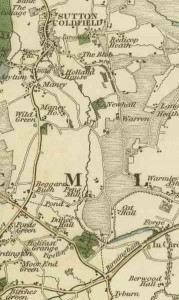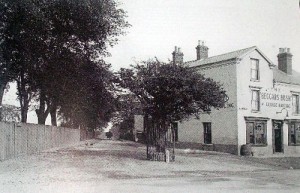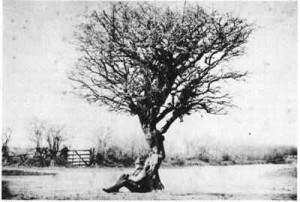Oscott, Sutton Coldfield, Warwickshire Beggars Bush 1821
The Beggars Bush Inn stands at a crossroads on a main road and there is still a bush. However, neither are the originals, and the name has been applied to several other places, pubs & bushes in the area. It is probably impossible now to fix the original location. It also has a naming story, which cannot be verified. If nothing else the history shows the popularity of the name, and how it can become attached to local features.
Duignan, W.H. Notes of Staffordshire Place Names, London, 1902, says for the Beggars Bush place name; “There is a large hawthorn bush here which stands on the boundary of Sutton Coldfield and Perry Barr, and of the counties of Stafford and Warwick; also on the old road from London to Chester. I know nothing of its history, but the name is common.” Williams, K.J., A History of New Oscott (unpublished typescript Birmingham Central Library) (1985) says the name was applied to the area on which Oscott College was built in 1838, and was then associated with a hawthorn bush at the top of Jockey Road, at the junction with Chester Road and King’s Road, the present location. Williams says the location is shown on a map dated 1821 which he does not identify.
The earliest record of Beggars Bush in this area is on Greenwood’s Map surveyed in 1820/1. This shows Beggars Bush about a mile east of the present location, south of Wild Green, on what is now the A5127 near Chester Road Station. This site too is on a parish boundary. This suggests that the present site and pub acquired the name from the earlier location. The First Series OS (surveyed in 1834) does show the current location as Beggars Bush (near Gibbet Hill and Jordan’s Grave) but does not show any buildings at the junction.
Local tradition was that it name arose from a dispute over the costs of burying a tramp who died under a bush on the parish boundary, which is referred to in Peers, A, A History and Guide to Sutton Park, 1869. The modern site was on parish and boundary boundaries, and the Greenwood site was on parish boundary. However, there is no source or date for the story and it seems romantic. Parishes did dispute and go to law over the ongoing maintenance of the poor, but burial costs were small in comparison. The name source story is still current and was repeated in 1995 and 2005 in reports that attempts to change the name were abandoned because of local pressure.
The current Beggars Bush Inn was not so called originally. In 1866 there was a Hawthorn Bush Inn to the north of the present pub. A local history site says “The origins of the Bush Inn on the Warwickshire side are not known, but a public house stood there in 1841; its landlord was William Goodwin . . . In 1861 Goodwin took a new lease . . . built a new pub (adjacent in Jockey Lane) and five cottages and converted the old pub building into three cottages . . . The name change took place between 1891 and 1907; a photograph bearing the latter date clearly shows the name to be ‘The Beggars Bush’ . . . The building was demolished and a new one erected in the 1930s.” However, there is a record of a pub of that name in 1887 (Birmingham City Archives, MS 3834/40) and references to “at” or “near” Beggars Bush in conveyances in 1851 and 1871 ((Birmingham City Archives, MS 3145/126/1-2). The pub on the present site is recorded in Directories as The Bush in 1900 but is The Beggars Bush in 1908. A photographs from this period shows both the pub and probably the bush itself.
The bush was protected by iron railings until destroyed by road widening in 1930’s after which a new bush was planted, in response to pressure from local residents. Peers and Williams both note the distinctiveness of the old and new bush, Peers saying that in spring” the Beggar’s Bush is a thing of beauty standing in the road covered with its silver blossom” and Williams to the new bushes “copper hue” in Autumn. The possibility of the Bush being a shelter is unlikely given its form, and Williams also refers to another site Butlers Oven on the site of the College that was a sheltered hollow used for shelter by shepherds.
This lovely photograph shows a picturesque “beggar” in situ beneath the alleged Beggars Bush at Oscott. However, the landscape does not seem to be consistent the present location. There are at least three photographs in Birmingham Central Library (search for “Beggars Bush”) allegedly of the original bush and pub, which do not seem to show the same bush as this, or to be of the same bush themselves. It seems that the name has moved from bush to bush.
Grid
SP100940
Sources
Field, J., English Field-Names; A Dictionary, Newton Abbott, 1993, p.17
EPNS Warwickshire
C. and J. Greenwood Map of the County of Warwick from Actual Survey made in the Years 1820 and 1821.
William Dargue A History of Birmingham Places & Placename
Thanks
John Pile, Bill Dargue, Birmingham Central Library, Oscott College
Posted: March 13th, 2011 | Filed under: Places | Tags: Oscott, Sutton Coldfield, Warwickshire, beggars, maps, naming story, pubs | 2 Comments »




My grandfather Alfred Marson was landlord of the Beggars Bush, certainly in 1920 but possibly earlier. I have two photographs showing his name on the building as landlord, the earlier offering stabling for horses and the later providing garaging for cars.
My 3xgreat-grandfather was the George Harding whose name is on the front of this pub in the image sourced here dated c.1908. In the 1901 census his father, also George Harding, my 3xgreat-grandfather was listed as the licensed victualler of “The Bush Inn’, so it hadnt yet earned its name as “The Beggars Bush”. In 1901 George Senior, a widower, lived here with his son George Junior, his wife, and their three children. In addition they had two domestic servants, an ostler, and one boarder staying here on the night of the 1901 census; a headteacher from a school in London. In 1904 George had passed away and George Junior decided not to carry on the family trade and moved into work as a butcher. By the 1911 census the publican is listed as a Charles Newey and the pub is listed as the ‘Beggars Bush’ with ten rooms.